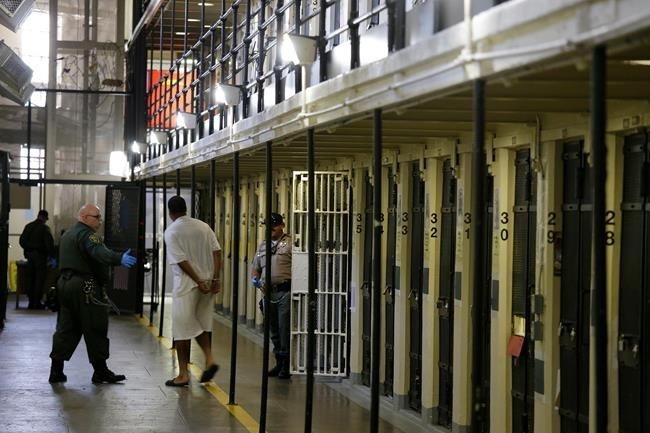SACRAMENTO, Calif. (AP) ŌĆö California Gov. Gavin Newsom, who three years ago placed a moratorium on executions, now is moving to dismantle the United States' largest death row by moving all condemned inmates to other prisons within two years.
The goal is to turn the section at San Quentin State Prison into a "positive, healing environment.ŌĆØ
ŌĆ£We are starting the process of closing death row to repurpose and transform the current housing units into something innovative and anchored in rehabilitation,ŌĆØ corrections department spokeswoman Vicky Waters told The Associated Press.
California, which last carried out an execution in 2006, is one of 28 states that maintain death rows, along with the U.S. government, according to the While other states like Illinois have abolished executions, California is merging its condemned inmates into the general prison population with no expectation that any will face execution anytime in the near future.
Oregon similarly transferred its much smaller condemned population to other inmate housing two years ago.
Newsom, a Democrat, imposed a moratorium on executions in 2019 and shut down the stateŌĆÖs execution chamber at San Quentin, north of San Francisco. Now his administration is turning on its head a 2016 voter-approved initiative intended to expedite executions by capitalizing on one provision that allowed inmates to be moved off death row.
ŌĆ£The underlying motive of the administration is to mainstream as many of these condemned murderers as possible,ŌĆØ said Michael Rushford, president of the Criminal Justice Legal Foundation, which backed the initiative. ŌĆ£Our objective was to speed up the process.ŌĆØ
He added he doesn't think victims are happy with the administration's decision.
ŌĆ£TheyŌĆÖre moving condemned murderers into facilities that are going to make their lives better and offer them more amenities, while the victims still mourn the death of their family member,ŌĆØ Rushford said.
Corrections officials began a voluntary in January 2020 that as of Friday had moved 116 of the stateŌĆÖs 673 condemned male inmates to one of seven other prisons that have maximum security facilities and are surrounded by lethal electrified fences.
They intend to submit permanent proposed regulations within weeks that would make the transfers mandatory and ŌĆ£allow for the repurposing of all death row housing units,ŌĆØ Waters said.
The approved six years ago also required condemned inmates to participate in prison jobs, with 70% of the money going for restitution to their victims, and corrections officials said thatŌĆÖs their goal with the transfers. By the end of last year, more than $49,000 in restitution had been collected under the pilot program.
NewsomŌĆÖs proposed budget for the fiscal year starting July 1 to find new uses for the vacant condemned housing.
It notes that death row and its supporting activities are in the same area as facilities used for rehabilitation programs for medium-security San Quentin inmates. The money would be used to hire a consultant to ŌĆ£develop options for (the) space focused on creating a positive, healing environment to provide increased rehabilitative, educational and health care opportunities.ŌĆØ
San QuentinŌĆÖs never-used $853,000 execution chamber is in a separate area of the prison, and there are no plans to ŌĆ£repurposeŌĆØ that area, Waters said.
California voters supported the death penalty in 2012 and 2016, though legislative opponents have said they hope to put the issue before voters again in coming years. An advisory panel to Newsom and lawmakers, the Committee on Revision of the Penal Code, in November became the latest to recommend repealing the death penalty, calling it
Under the stateŌĆÖs transfer program, condemned inmates moved to other prisons can be housed in if officials decide they cannot be safely housed with others, although they are supposed to be interspersed with other inmates. Inmates on death row are housed one to a cell, but the transferred inmates can be housed with others if itŌĆÖs deemed safe.
ŌĆ£There have been no safety concerns, and no major disciplinary issues have occurred,ŌĆØ Waters said.
When it comes to jobs and other rehabilitation activities, condemned inmates outside death row are treated similarly to inmates serving sentences of life without parole. That includes a variety of jobs such as maintenance and administrative duties, according to prison officials.
The condemned inmates are counted more often and are constantly supervised during activities, officials said.
Under current rules, condemned inmates can be transferred unless they are in restricted housing for disciplinary reasons, have pending charges, or have been found guilty of certain disciplinary offenses in the past five years.
But they also are ŌĆ£carefully screened to determine whether they can safely participate in the program,ŌĆØ according to the department. That includes things like each inmateŌĆÖs security level, medical, psychiatric and other needs, their behavior, safety concerns and notoriety.
Female condemned inmates are housed at the Central California WomenŌĆÖs Facility in Chowchilla. They can transfer to less restrictive housing within the same prison, and eight of the 21 have done so.
The men can be moved to California Correctional Institution; California Medical Facility; California State Prison, Corcoran; Centinela State Prison; Kern Valley State Prison; Richard J. Donovan Correctional Facility; or Salinas Valley State Prison.
Don Thompson, The Associated Press



